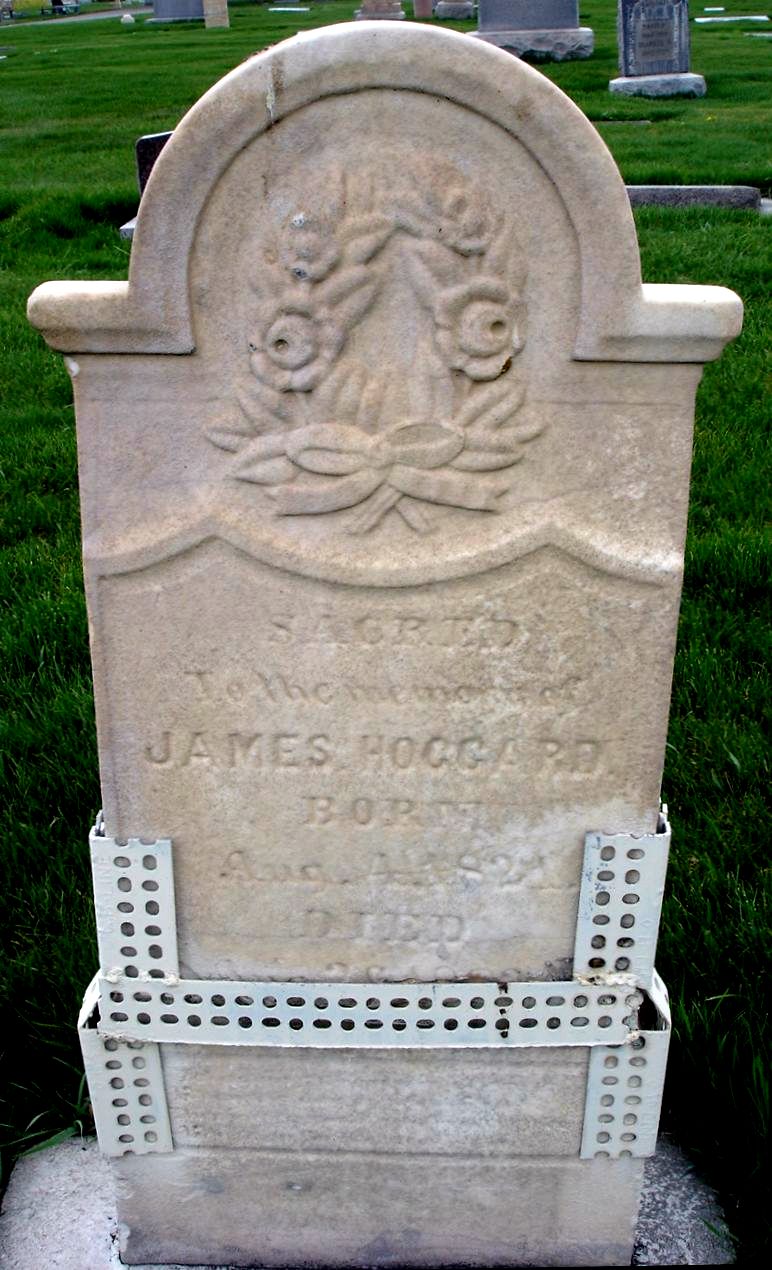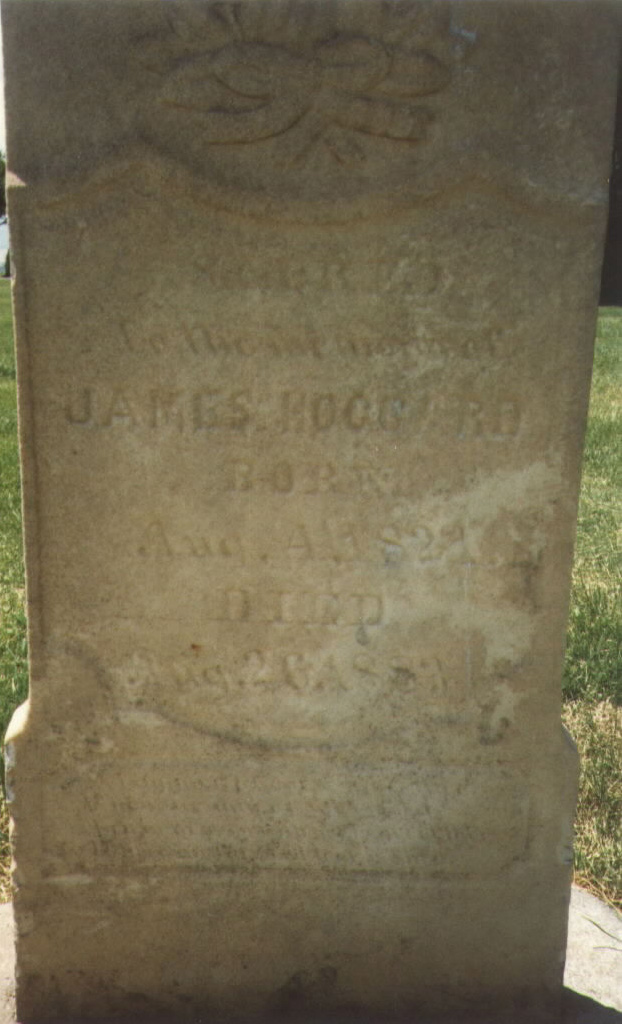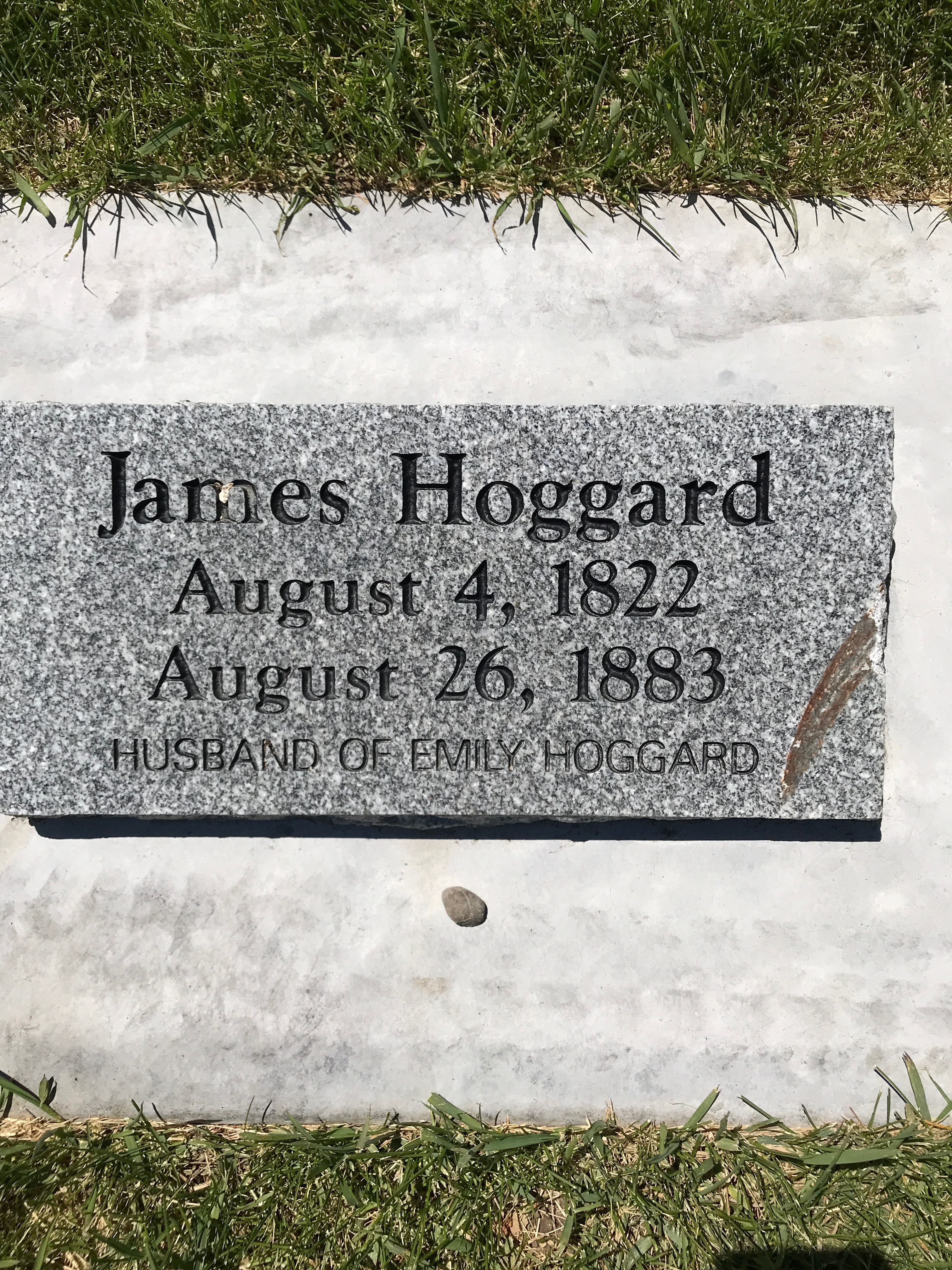James married Emily Blacknell on 26 February 1842, when he was nineteen and she was seventeen. They made their home in Calverton, near Emily’s family.
After careful planning and arranging, James Hoggard left his wife and family behind and came to America to make a place for them with other members of the LDS Church. Emily was left behind with four small children: Mary, Elizabeth, George and James. One son, Samuel, had died at the age of five. Not long after James left for America, another little girl, Dorothy, was born.
James was thirty years old when he set sail from England on the ship Germanicus, under Captain Falls, on 4 April 1854. One of the passengers who crossed the Atlantic in this company wrote the following statement: "They left Liverpool bound for the United States with about five hundred passengers on board the ship, which was a sailing vessel. About one half of the people on board were Latter Day Saints. They became lost and tried to find the trade winds but failed. When near the West Indies, some of the sailors went on shore to get water as the ships supply was running low. The food supply was also low, so it was necessary to go on rations. Here they were in a dead calm for twenty days, with the thermometer reading 120 degrees in the shade. They took on board a few casks of water near Cuba. Here again the ship struck bottom and was compelled to stand still until the next day when the tide came in. The sailors then tied ropes to the ship and pulled it off the bottom in a row boat."
The ship arrived in New Orleans on 12 June 1854, having spent sixty-seven days in the voyage from Liverpool. From this point they shipped on the steamboat Uncle Sam, destined for St. Louis, Missouri. They landed there on 24 July 1854. The price of the ticket was $3.50. Fourteen days were spent in quarantine on an island below St. Louis where many of the company died.
James worked and saved for a year and then sent for his wife and family, and on 26 April 1855, Emily and her five children set sail on the ship William Stetson for New York. There were two hundred twenty nine saints on board and Elder Aaron Smithwist was in charge of them. Emily was ill most of the way and Mary, who was only ten years old, was pressed into service to cook, nurse and babysit. The trip was hard on all of them. Their cup of sorrow ran over when baby Dorothy died from a sudden illness and had to be buried at sea.
James was waiting for them, when they arrived in New York. He was eager to welcome them to their new land and anxious to take the baby he had never seen in his arms. His sorrow and disappointment was great when he learned of her death, and he realized what Emily had endured alone. He was very thankful for the safe arrival of the rest of his family and they were all happy to be together again.
The family stayed at Burlington, Iowa, and they began to work and save for the trip to Utah. Emily went out to sew for people and James worked on a boat on the Mississippi River. It was dangerous work but paid a good wage. In a years time they had the means to continue their journey. Their son Hyrum was born 22 March 1856. Just three weeks later they left for Utah. They traveled with Captain Merrill’s Ox Team Company. Emily had to ride most of the way in the wagon since she wasn't very strong. Along the way, she had to give up the third of her children, James, who was just four years old, died and was buried along the way. It is hard to imagine the hardships and heartache they endured, but it makes me realize how much the gospel meant to them and the strength of their testimonies.
After a five month journey, they arrived in Salt Lake City on 11 September 1856. They were met by Heber C. Kimball and after a few days rest traveled on to American Fork with other saints. They arrived in American Fork on 15 September 1856 and camped by the creek that ran along the north wall of the fort. James went to work cutting hay and grain, and often waded in water up to his knees. He worked with brother Joshia Nicholes and they took squash and potatoes for their pay. Emily took her little family and went to glean the fields for dropped grain to eat. Brother Teltcher took the grain to Springville and brought back flour and this saw them through the long, hard winter. Thus began their life in the land of Zion, the place to which they came, because of their faith and love of the gospel.
James was a very broad-minded man, his motto in all his dealings was to give but never take. He was honest and generous to a fault. At no time in his life was he too busy or tired to go help a neighbor. He seemed to have the gift of healing, and people often came to him for help to set a broken bone or to be treated for cuts or wounds. He tended to sick animals as well as people and thought nothing of spending hours with a sick horse or cow. He felt it was his duty to do all he could for anyone who needed his help.
He was the first headwater master in American Fork, which position he held for twenty-one years. He had charge of all bridges and roads in the community and it was he who divided the water that came from American Fork Canyon. The water was shared with Lehi and Pleasant Grove, or Battle Creek as it was called then. He was very progressive and believed in home industry. He held stock in every cooperative project that would help the community in any way. As the years passed, due to hard work and thrift, the Huggard’s were as comfortable and prosperous as most of the people in the town. They were very generous and hospitable and no one ever went away hungry from their home. Strangers were made as welcome as friends and neighbors, and they opened their home to people just arriving to make a home in this land, and helped them to find work and get settled for themselves.
James and Emily now had everything to make them comfortable and happy. All was well with them until one day in the spring of 1883. James and Martha, the youngest daughter, were working in the field when James was stricken with a sunstroke and became very ill. He went and lay down under a tree on the ditch back to see if the sickness would pass. He finally sent Martha home, but he didn't get home until late in the afternoon. That was the last day he ever went to the field. He was ill all summer and on Sunday morning, 26 August 1883, his noble spirit went back to the God who gave it. At his funeral services, each speaker mentioned his outstanding honesty in all his dealings.
James married Emily Blacknell on 26 February 1842, when he was nineteen and she was seventeen. They made their home in Calverton, near Emily’s family.
After careful planning and arranging, James Hoggard left his wife and family behind and came to America to make a place for them with other members of the LDS Church. Emily was left behind with four small children: Mary, Elizabeth, George and James. One son, Samuel, had died at the age of five. Not long after James left for America, another little girl, Dorothy, was born.
James was thirty years old when he set sail from England on the ship Germanicus, under Captain Falls, on 4 April 1854. One of the passengers who crossed the Atlantic in this company wrote the following statement: "They left Liverpool bound for the United States with about five hundred passengers on board the ship, which was a sailing vessel. About one half of the people on board were Latter Day Saints. They became lost and tried to find the trade winds but failed. When near the West Indies, some of the sailors went on shore to get water as the ships supply was running low. The food supply was also low, so it was necessary to go on rations. Here they were in a dead calm for twenty days, with the thermometer reading 120 degrees in the shade. They took on board a few casks of water near Cuba. Here again the ship struck bottom and was compelled to stand still until the next day when the tide came in. The sailors then tied ropes to the ship and pulled it off the bottom in a row boat."
The ship arrived in New Orleans on 12 June 1854, having spent sixty-seven days in the voyage from Liverpool. From this point they shipped on the steamboat Uncle Sam, destined for St. Louis, Missouri. They landed there on 24 July 1854. The price of the ticket was $3.50. Fourteen days were spent in quarantine on an island below St. Louis where many of the company died.
James worked and saved for a year and then sent for his wife and family, and on 26 April 1855, Emily and her five children set sail on the ship William Stetson for New York. There were two hundred twenty nine saints on board and Elder Aaron Smithwist was in charge of them. Emily was ill most of the way and Mary, who was only ten years old, was pressed into service to cook, nurse and babysit. The trip was hard on all of them. Their cup of sorrow ran over when baby Dorothy died from a sudden illness and had to be buried at sea.
James was waiting for them, when they arrived in New York. He was eager to welcome them to their new land and anxious to take the baby he had never seen in his arms. His sorrow and disappointment was great when he learned of her death, and he realized what Emily had endured alone. He was very thankful for the safe arrival of the rest of his family and they were all happy to be together again.
The family stayed at Burlington, Iowa, and they began to work and save for the trip to Utah. Emily went out to sew for people and James worked on a boat on the Mississippi River. It was dangerous work but paid a good wage. In a years time they had the means to continue their journey. Their son Hyrum was born 22 March 1856. Just three weeks later they left for Utah. They traveled with Captain Merrill’s Ox Team Company. Emily had to ride most of the way in the wagon since she wasn't very strong. Along the way, she had to give up the third of her children, James, who was just four years old, died and was buried along the way. It is hard to imagine the hardships and heartache they endured, but it makes me realize how much the gospel meant to them and the strength of their testimonies.
After a five month journey, they arrived in Salt Lake City on 11 September 1856. They were met by Heber C. Kimball and after a few days rest traveled on to American Fork with other saints. They arrived in American Fork on 15 September 1856 and camped by the creek that ran along the north wall of the fort. James went to work cutting hay and grain, and often waded in water up to his knees. He worked with brother Joshia Nicholes and they took squash and potatoes for their pay. Emily took her little family and went to glean the fields for dropped grain to eat. Brother Teltcher took the grain to Springville and brought back flour and this saw them through the long, hard winter. Thus began their life in the land of Zion, the place to which they came, because of their faith and love of the gospel.
James was a very broad-minded man, his motto in all his dealings was to give but never take. He was honest and generous to a fault. At no time in his life was he too busy or tired to go help a neighbor. He seemed to have the gift of healing, and people often came to him for help to set a broken bone or to be treated for cuts or wounds. He tended to sick animals as well as people and thought nothing of spending hours with a sick horse or cow. He felt it was his duty to do all he could for anyone who needed his help.
He was the first headwater master in American Fork, which position he held for twenty-one years. He had charge of all bridges and roads in the community and it was he who divided the water that came from American Fork Canyon. The water was shared with Lehi and Pleasant Grove, or Battle Creek as it was called then. He was very progressive and believed in home industry. He held stock in every cooperative project that would help the community in any way. As the years passed, due to hard work and thrift, the Huggard’s were as comfortable and prosperous as most of the people in the town. They were very generous and hospitable and no one ever went away hungry from their home. Strangers were made as welcome as friends and neighbors, and they opened their home to people just arriving to make a home in this land, and helped them to find work and get settled for themselves.
James and Emily now had everything to make them comfortable and happy. All was well with them until one day in the spring of 1883. James and Martha, the youngest daughter, were working in the field when James was stricken with a sunstroke and became very ill. He went and lay down under a tree on the ditch back to see if the sickness would pass. He finally sent Martha home, but he didn't get home until late in the afternoon. That was the last day he ever went to the field. He was ill all summer and on Sunday morning, 26 August 1883, his noble spirit went back to the God who gave it. At his funeral services, each speaker mentioned his outstanding honesty in all his dealings.
Family Members
Advertisement
Records on Ancestry
Advertisement


















